WIPO关于PCT文件翻译的质量标准(修改)
- 格式:pdf
- 大小:3.31 MB
- 文档页数:33
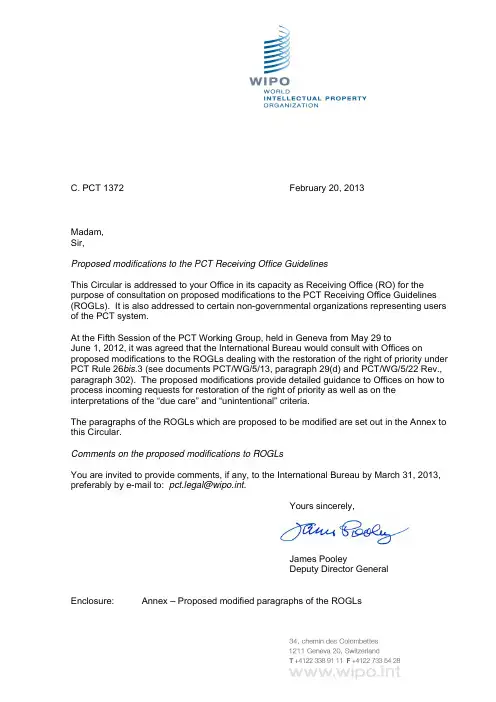
C. PCT 1372 February 20, 2013Madam,Sir,Proposed modifications to the PCT Receiving Office GuidelinesThis Circular is addressed to your Office in its capacity as Receiving Office (RO) for the purpose of consultation on proposed modifications to the PCT Receiving Office Guidelines (ROGLs). It is also addressed to certain non-governmental organizations representing users of the PCT system.At the Fifth Session of the PCT Working Group, held in Geneva from May 29 toJune 1, 2012, it was agreed that the International Bureau would consult with Offices onproposed modifications to the ROGLs dealing with the restoration of the right of priority under PCT Rule 26bis .3 (see documents PCT/WG/5/13, paragraph 29(d) and PCT/WG/5/22 Rev., paragraph 302). The proposed modifications provide detailed guidance to Offices on how to process incoming requests for restoration of the right of priority as well as on theinterpretations of the “due care” and “unintentional” criteria.The paragraphs of the ROGLs which are proposed to be modified are set out in the Annex to this Circular.Comments on the proposed modifications to ROGLsYou are invited to provide comments, if any, to the International Bureau by March 31, 2013, preferably by e-mail to: pct.legal@wipo.int .Yours sincerely,James PooleyDeputy Director GeneralEnclosure: Annex – Proposed modified paragraphs of the ROGLsPCT RECEIVING OFFICE GUIDELINESRestoration of the Right of Priority166A. The receiving Office should restore the right of priority if the applicant requests restoration within two months from the expiration of the priority period and satisfies the criteria applied by the Office and the requirements under Rule 26bis.3.166B. Restoration of the Right of Priority − Non-Acceptance by Receiving Office. Where a receiving Office has notified the International Bureau under Rule 26bis.3(j) of the incompatibility of Rule 26bis.3(a) to (i) with the national law applied by that Office, but nevertheless receives a request to restore the priority right, the receiving Office promptly requests the International Bureau as receiving Office to agree, in accordance with the procedure outlined in paragraphs 278 to 281, to the transmittal of the international application under Section 333(b) and (c). An Office may also proceed s in this manner if it only applies one of the applicable criteria and the applicant requests restoration under the criterion not applied by the Office.166C B. Receipt of a Request for the Restoration of the Right of Priority. The applicant may request restoration of the right of priority directly on the request form (Box No. VI) or by filing a separate request within the time limit provided in Rule 26bis.3(e). The receiving Office checks if whether the request form contains a request by the applicant to restore the right of priority in Box No. VI. If the receiving Office receives a separate restoration request, the Office promptly notifies the International Bureau of it and transmits a copy of the restoration request to the International Bureau (item 6 of Form PCT/RO/118). Where the applicant submits a separate statement of reasons, a declaration or other evidence as part of the restoration request, the receiving Office promptly transmits a copy of any of these documents to the International Bureau (item 12 of Form PCT/RO/118).If such a request to restore is filed subsequently, the receiving Office promptly notifies the International Bureau of the request (item 6 of Form PCT/RO/118).166D. Time Limit under Rule 26bis.3(e) for Requesting Restoration of the Right of Priority. The applicant is required to file the restoration request, submit a statement of reasons for the failure to file the international application within the priority period, claim priority of an earlier application in the international application and pay any fees required for requesting restoration within The time limit to request to restore the priority right and to comply with the requirements listed in paragraphs (a), (b) and (c) of paragraph 166B above is two months from the date on which the priority period expired. Where the applicant makes a request for early publication under Article 21(2)(b), any request to restore the right of priority must be submitted and the all of these requirements mentioned above must be complied with before the technical preparations for international publication have been completed (Rule 26bis.3(e)). If the receiving Office requires the applicant to provide a declaration or evidence in support of the statement of reasons for failure to timely file the international application (Rule 26bis.3(f)), it invites the applicant within a time limit which is reasonable under the circumstances, to furnish such documents. If the receiving Office intends to refuse the request to restore the right of priority (Rule 26bis.3(g)), it allows the applicant to make observations within a time limit which is reasonable under the circumstances (Form PCT/RO/158). In this notification, the receiving Office may also request that a declaration or evidence be furnished (see paragraph 166G).166E. Checking of Formal Requirements.Upon receipt of a request to restore the right of priority, T t he receiving Office then promptly checks whether the following requirements are met:(a) the international filing date of the international application is later than the date onwhich the priority period expired but within two months from that date (Rule 26bis.3(a));(b) a A priority claim to an earlier application is made in the international application or issubsequently added, pursuant to Rule 26bis.1(a) within the applicable time limit under Rule26bis.3(e);.(c)(b)the request to restore the right of priority and a A statement of reasons for failureto file the international application within the priority period has have both beensubmitted furnished (see also paragraph 166F below) within the applicable time limit under Rule 26bis.3(e) (for the statement, see also paragraph 166F below); and.(d) (c) T t he fee for requesting restoration, if applicable, has been paid (Rule 26bis.3(d))within the applicable time limit under Rule 26bis.3(e). The time limit for payment of the fee may be extended for a period of up to two months from the expiration of that thetime limit under Rule 26bis.3(e)(Rule 26bis.3(d)).(d) If required by the receiving Office, a declaration or evidence in support of thestatement of reasons for failure to file the international application within the priorityperiod has been furnished.If any of the above requirements are not complied with, and the applicable time limithas not yet expired, the receiving Office promptly invites the applicant (FormPCT/RO/132) to comply with that requirement within the applicable time limit. If any of the above requirements are not complied with after the applicable time limit, thereceiving Office notifies the applicant (Form PCT/RO/158) of the deficiency. If thereceiving Office intends to refuse the request to restore the right of priority, it should so indicate in detail in Form PCT/RO/158 and provide s the applicant with an opportunity to make observations within a reasonable time limit (Rule26bis.3(g)).166C. Separate Request to Restore the Right of Priority.A request to restore the right of priority may also be submitted separately from the request form. The receiving Office should process such separate requests in the same manner and according to the procedures outlined in paragraphs 166A to 166I.166D. Time Limit for Requesting Restoration of the Right of Priority.The time limit to request to restore the priority right and to comply with the requirements listed in paragraphs (a), (b) and (c) of paragraph 166B above is two months from the date on which the priority period expired. Where the applicant makes a request for early publication under Article 21(2)(b), any request to restore the right of priority must be submitted and the requirements mentioned above must be complied with before the technical preparations for international publication have been completed (Rule 26bis.3(e)). If the receiving Office requires the applicant to provide a declaration or evidence in support of the statement of reasons for failure to timely file the international application (Rule 26bis.3(f)), it invites the applicant within a time limit which is reasonable under the circumstances, to furnish such documents. If the receiving Office intends to refuse the request to restore the right of priority (Rule 26bis.3(g)), it allows the applicant to make observations within a time limit which is reasonable under the circumstances (Form PCT/RO/158). In this notification, the receiving Office may also request that a declaration or evidence be furnished (see paragraph 166G). 166E. Decision to Restore the Right of Priority.The receiving Office, when deciding on a request for restoration, is free to apply either the more strict criterion of “due care” or the less strict criterion of “unintentionality”(Rule 26bis.3(a)). The receiving Office may also apply both criteria. In such a case, the Office is free to apply, upon request by the applicant or at its own initiative, first the “due care” criterion and, if it finds that that criterion is not satisfied, the “unintentionality” criterion. If the receiving Office applies both criteria and finds that the failure to timely file the international application was unintentional but that due care had not been exercised, the receiving Office may indicate this intent to partially refuse restoration of priority under the due care criterion in Form PCT/RO/158, and explain that restoration will nevertheless be allowed under the unintentional criterion, by text in the Annex to that Form. If the applicant requests the restoration of multiple priority claims, and where the use of a single Form (PCT/RO/158and/or PCT/RO/159) would not be sufficiently clear, the receiving Office should use a separate Form for each priority claim concerned.166F. Statement of Reasons.Rule 26bis.3(b)(ii) requires that a request to restore the right of priority should state the reasons for failure to timely file the international application. The applicant should therefore provide a summary of the facts or circumstances surrounding the failure to file the international application in time including, where applicable, actions that were taken by the applicant to prepare and file the international application.166F. Statement of Reasons. Under Rule 26bis.3(b)(ii), the applicant is required to explain why he failed to file the international application within the priority period. The statement should describe in detail the facts and circumstances that led to the late filing and any remedial or alternative steps taken to attempt a timely filing of the international application. If the receiving Office finds the statement of reasons insufficient to determine whether the applicant satisfies the applicable criteria, the receiving Office may invite the applicant to submit further information by way of a revised statement within a reasonable time limit (item2 of Form PCT/RO/158). The receiving Office explains in detail, by text in the Annex to that Form, why it finds the statement insufficient. In this notification, the receiving Office may also require the applicant to submit a declaration or other evidence in support of the statement of reasons (see paragraph 166G). If the applicant does not respond to that notification within the time limit, the receiving Office proceeds as outlined in paragraph 166O. If the applicant submits new arguments in response to that notification and the receiving Office decides to restore the right of priority, the Office proceeds as outlined inparagraph166O. If the applicant submits new arguments in response to that notification and the receiving Office nevertheless intends to (partially) refuse the request to restore the right of priority, the receiving Office proceeds as outlined in paragraph 166N.166G166G. Declaration and Evidence. Under Rule 26bis.3(f), the receiving Office may require the applicant to submit a declaration or other evidence in support of the statement of reasons be furnished or, if some evidence has already been provided, that to submit additional evidence be furnished. within a reasonable time limit (items 3 and 4 ofForm PCT/RO/158). For the “unintentionality unintentionality” criterion, a statement indicating that the failure to comply with the priority period was not intentional on purpose should generally be sufficient. The receiving Office may, however, require that this statement be submitted in the form of a declaration. For the “due care” criterion, the receiving Office may require that the statement of reasons is substantiated with a declaration or other evidence. The submitted declaration or evidence should enable the receiving Office to determine whether the failure to file the international application within the priority period occurred in spite of due care, that is, if all reasonable care was taken under the circumstances to ensure that the priority period would not be missed.166H. Criteria Applied by the Receiving Office. The receiving Office, when deciding on a request for restoration, is free to apply either the more strict criterion of “due care”(Rule 26bis.3(a)(i)) or the less strict criterion of “unintentionality” (Rule 26bis.3(a)(ii)). The receiving Office may also apply both criteria. In such a case, since a positive finding of “due care” in effect encompasses a finding of “unintentional” conduct, the receiving Office should,unless the applicant requests otherwise, first apply the “due care” criterion, and only if this standard has not been complied with, apply the “unintentionality” criterion.166I. Unintentionality Criterion. Under Rule 26bis.3(a)(ii), the receiving Office should restore the right of priority if it finds that the failure to file the international application within the priority period was “unintentional”. The applicant satisfies this criterion if he demonstrates that he did not deliberately refrain from filing the international application within the priority period and that he had a continuing underlying intention to file the PCT application within the priority period. The receiving Office should focus on the applicant’s intent at the time when the priority period expired, irrespective of any changes in the applicant’s intent before or after the expiration of the priority period.166J. Due Care Criterion. Under Rule 26bis.3(a)(i), the receiving Office should restore the right of priority if it finds that the failure to file the international application within the priority period occurred in spite of “due care” required by the circumstances having been taken. Generally, the standard of having exercised “due care” within the meaning ofRule 26bis.3(a)(i) can only be met if the applicant has taken all measures which a reasonably prudent applicant would have taken. In determining whether the applicant exercised the “due care” of a reasonably prudent person, the receiving Office considers the facts and circumstances of each particular case. It is not sufficient for an applicant to demonstrate that, in general, he has taken all precautions to adhere to time limits for filing international applications. Instead, the applicant must show that he exercised all “due care” for the particular application in question. The receiving Office should engage in a factual analysis of the applicant’s specific acts related to the filing of the international application up to the expiration of the priority period. Actions by the applicant after the expiration of the priority period should not be considered when determining whether the applicant exhibited “due care”.166K.Where the applicant is represented by an agent, both the applicant and the agent must show that they exercised “due care” in order to satisfy the “due care” criterion (see Rule90.3(a)). In such a case, the applicant also has to demonstrate prudent action in the selection, appointment and sufficient instruction of a qualified agent.166L. For a corporate applicant or agent to satisfy the “due care” criterion, the applicant or agent generally must demonstrate that a reliable docketing, back-up and reminder system has been established, that reliable, adequately trained and supervised staff has used these systems and did not make mistakes in the past, and that the failure to file within the priority period in this particular case was an isolated incident. While the same standard cannot be expected from a small applicant or agent, such as an individual inventor or a small and medium enterprise, any applicant or agent is expected to set up an efficient and reliable reminder, supervision and back-up system which corresponds to best practices in the field. 166M. While each receiving Office must engage in its own case-by-case analysis for each restoration request, the application of the “due care” criterion to the following factual circumstances (based on the experience of the International Bureau) may be of assistance:(a) Lack of Knowledge by the ApplicantA prudent applicant acquires the requisite knowledge of the PCT system in order to beable to timely file a complete international application, and/or appoints a competentagent to file on his behalf if the applicant lacks the requisite knowledge. An applicant who failed to file the international application within the priority period due to a lack of knowledge concerning the operation of the PCT system or concerning the 12 months priority period as set out in Article 4C of the Paris Convention generally did not act with “due care”.(b) Human Error by the Applicant or Agent HimselfA reasonably prudent applicant or agent recognizes the importance of meeting crucial priority deadlines and ensures that all aspects of the preparation and filing of the international application are carried out with the diligence and meticulousness needed to successfully and timely submit the international application. A human error attributable to increased workload, lost files and incompletely filed PCT applications generally lacks “due care”.(c) Miscommunication between the Applicant and the AgentWhere the applicant appoints an agent, both the applicant and the agent must act with “due care” in their communication with each other. A prudent applicant instructs the agent in a clear and timely manner to file the international application. A prudent agent acts upon instructions received by the applicant and clarifies with the applicant in case of doubt. A prudent agent advises the applicant of all important matters in relation to the timely filing of an international application and the consequences of a late filing in a clear manner. A prudent applicant or agent finds alternative ways to communicate with the other person if the usual communication channels fail. Where the failure to timely file a PCT application was caused by technical difficulties (e.g. unexpected email delivery failure between the applicant and the agent), both the applicant and the agent may have acted with “due care” if they can demonstrate that the system had worked reliably in the past and that the breakdown could not have been anticipated by either party.(d) Absence from the Office by the Applicant or AgentWhere an applicant or agent is absent from the office at the expiration of the priority period, a prudent applicant or agent either files the international application in advance insofar as the absence was predictable, or instructs another person to timely file the international application during his absence. For example, a prudent applicant with a scheduled absence from the Office due to vacation or a medical appointment checks whether the priority period for the filing of an international application expires during this absence and instructs an agent, a colleague or a staff member to file the international application on his behalf. In addition, a prudent agent/applicant maintains a reliable communication system that provides other persons in the office with access to important communications so that other persons can receive and react upon filing instructions in case of unplanned absences. For example, a prudent agent ensures that instructions to file an international application are sent to an email account to which several persons have access. An applicant or agent generally fails to demonstrate “due care” if he failed to timely file a PCT application due to illness or vacation. Only in cases where the applicant or agent fell unexpectedly ill and needed urgent treatment that prohibited all communication with other persons the failure to timely file an international application may have occurred in spite of “due care”.(e) Human Error by the Agent’s or Applicant’s StaffAn applicant or agent may entrust administrative staff (non-attorneys such as assistants or paralegals) with the performance of certain administrative tasks. A prudent applicant or agent carefully chooses, trains and monitors the work of a reliable, experienced, adequately trained and supervised employee. A human error by an assistant in the docketing, monitoring, preparation or filing of the international application is not attributed to the applicant or agent if the applicant or agent can show that “due care” was exercised in the management of the assistant and the failure to filewithin the priority period in this particular case was an isolated human error. In the statement of reasons, the applicant or agent should usually outline the number of years the assistant has been entrusted with the particular task, the level of training and supervision provided to the assistant, and whether the assistant has performed all his duties diligently in the past.(f) Docketing System ErrorDocketing system errors can be divided into human entry errors (see paragraphs (b) and (e) above) and technical errors (e.g. software malfunction or server crashes). Where the applicant or agent failed to timely file the international application due to a technical error, the applicant or agent may have acted with all “due care” if he demonstrates that he set up a reliable and well functioning reminder system, had sufficient knowledge of the use and operation of the system, sufficiently trained and supervised staff on the use of the system, arranged reliable back-up and entry review (a second person that independently checks the correct entry of dates) procedures, and that the technical error occurred unexpectedly and was as such not foreseeable. (g) Facsimile or Software Submission FailureWhere an applicant or agent fails to timely file a PCT application due to a transmission error using facsimile, or any filing software, an applicant or agent has to show that the error occurred due to an external technical problem that was beyond theapplicant’s/agent’s control in order to satisfy the “due care” criterion (for facsimile submissions, see also Rule 92.4(c) which puts the risk of an unsuccessful transmission on the side of the applicant). A prudent applicant or agent takes particular care and vigilance when he files an international application on the last day or even during the last hours of the priority period. This includes the preparation of the necessary facilities for the filing of the PCT application reasonably in advance of the expiration of the priority period, such as where the applicant or agent chooses to file electronically, a well-functioning computer system, the installation of the latest filing software and the digital certificate, a reliable Internet connection and sufficient knowledge of the software used, and where the applicant or agent chooses to file via facsimile, a well-functioning fax machine. Where a prudent applicant or agent experiences technical problems during the submission of an international application, the applicant or agent exhausts all reasonable alternative means to timely file the international application (such as hand delivery, express mail, submission via fax instead of electronic filing, use of a different fax machine, submission to a different fax number within the same receiving Office, filing with another receiving Office in a different time zone which is competent for the main applicant).(h) Postal Service DifficultiesWhere an applicant fails to timely file a PCT application due to postal service errors, the receiving Office should apply the underlying idea of Rule 82.1 when evaluating whether an applicant or agent acted with all “due care” required by the circumstances. A prudent applicant or agent mails an international application to the receiving Office at least five days prior to the expiration of the priority period by registered airmail (applicants or agents need not use airmail if surface mail normally arrives within two days of mailing or if airmail is unavailable). The applicant or agent may have acted with all “due care” if the filing of the international application would have been timely under normal circumstances and the postal delay was unforeseeable.(i) Force MajeureAn event of force majeure means external, unforeseeable and/or unavoidablecircumstances beyond the control of the applicant or agent. Disasters, such ashurricanes, volcanic eruptions, earthquakes, international conflicts and war may beconsidered as such events. Generally, if such circumstances make it impossible for an applicant or agent to file the international application within the priority period, thefailure to file the application occurs in spite of “due care”. An applicant or agentgenerally acted with all “due care” if the applicant or agent demonstrates that theconsequences of the event could not have been predicted and/or avoided.166N. Intended (Partial) Refusal of the Request to Restore the Right of Priority. If the receiving Office intends to (partially) refuse the request to restore the right of priority(Rule26bis.3(g)), the Office notifies the applicant of the intended refusal and allows the applicant to make observations within a reasonable time limit (Form PCT/RO/158). In this notification, the receiving Office may also invite the applicant to submit a declaration or other evidence (see paragraph 166G). The receiving Office should explain in detail, by text in the Annex to that Form, why it intends to (partially) refuse the restoration request. If the receiving Office applies both the “due care” and the “unintentionality” criteria and finds that the failure to timely file the international application was “unintentional” but that “due care” had not been exercised, the receiving Office indicates the intent to partially refuse restoration of priority under the “due care” criterion, and explains that the right of priority will nevertheless be restored under the “unintentionality” criterion, by text in the Annex to Form PCT/RO/158.166I166O. Decision and Notification. As soon as the receiving Office decides to restore the right of priority or, after notifying the applicant of the intended refusal (see paragraph166N), decides to (partly) refuse the request to restore the right of priority has come to a decision on the request to restore the priority right, it , the Office promptly notifies the applicant of its decision (Form PCT/RO/159) and furnishes a copy thereof to the International Bureau (Rule 26bis.3(h)). In this notification, the receiving Office indicates whether the Office restores the right of priority or (partly) refuses the request to restore the right of priority and the criterion for restoration upon which the decision was based. In the Annex to the Form, the receiving Office summarizes the facts and the reasons for its decision. The receiving Office promptly submits a copy of its decision to the International Bureau, along with any correspondence between the Office and the applicant not previously submitted (such as Form PCT/RO/158, a copy of the request for restoration, the statement of reasons and of any accompanying declaration or other evidence).166P. Multiple Priority Claims. If the applicant requests the restoration of multiple priority claims, and where the use of a single Form (PCT/RO/158 and/or PCT/RO/159) would not be sufficiently clear, the receiving Office should use a separate Form for each priority claim concerned.[End of Annex]。
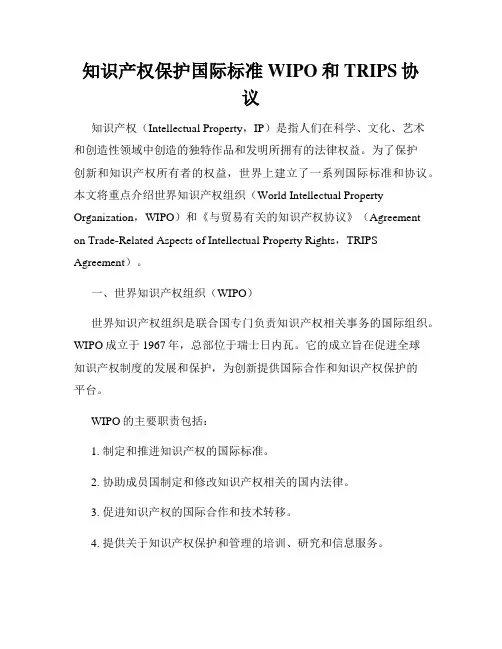
知识产权保护国际标准WIPO和TRIPS协议知识产权(Intellectual Property,IP)是指人们在科学、文化、艺术和创造性领域中创造的独特作品和发明所拥有的法律权益。
为了保护创新和知识产权所有者的权益,世界上建立了一系列国际标准和协议。
本文将重点介绍世界知识产权组织(World Intellectual Property Organization,WIPO)和《与贸易有关的知识产权协议》(Agreement on Trade-Related Aspects of Intellectual Property Rights,TRIPS Agreement)。
一、世界知识产权组织(WIPO)世界知识产权组织是联合国专门负责知识产权相关事务的国际组织。
WIPO成立于1967年,总部位于瑞士日内瓦。
它的成立旨在促进全球知识产权制度的发展和保护,为创新提供国际合作和知识产权保护的平台。
WIPO的主要职责包括:1. 制定和推进知识产权的国际标准。
2. 协助成员国制定和修改知识产权相关的国内法律。
3. 促进知识产权的国际合作和技术转移。
4. 提供关于知识产权保护和管理的培训、研究和信息服务。
WIPO通过制定国际公约、协议和条约来推进全球知识产权保护的合作。
其中最重要的是《世界知识产权组织公约》(Convention Establishing the World Intellectual Property Organization)。
该公约旨在推动全球知识产权保护的标准化和协调,为各成员国提供一个共同的法律框架。
二、《与贸易有关的知识产权协议》(TRIPS Agreement)《与贸易有关的知识产权协议》是世界贸易组织(World Trade Organization,WTO)的一个组成部分,旨在确保全球商业活动中知识产权的保护和合理使用。
TRIPS协议于1995年生效,是一个具有法律约束力的国际协议。
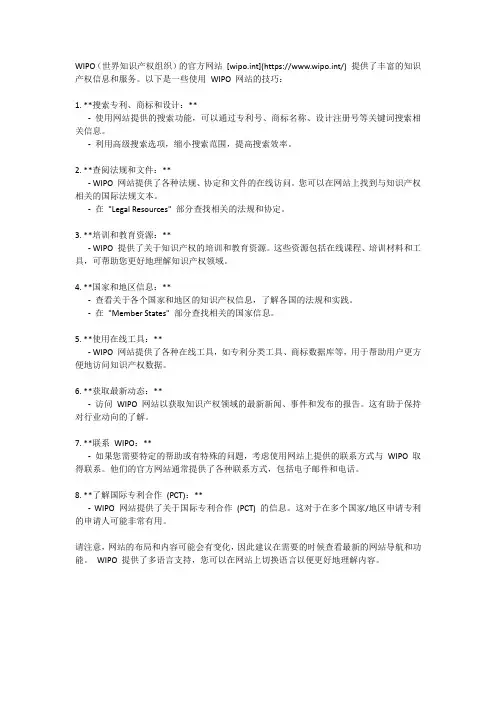
WIPO(世界知识产权组织)的官方网站[wipo.int](https://www.wipo.int/) 提供了丰富的知识产权信息和服务。
以下是一些使用WIPO 网站的技巧:1. **搜索专利、商标和设计:**-使用网站提供的搜索功能,可以通过专利号、商标名称、设计注册号等关键词搜索相关信息。
-利用高级搜索选项,缩小搜索范围,提高搜索效率。
2. **查阅法规和文件:**- WIPO 网站提供了各种法规、协定和文件的在线访问。
您可以在网站上找到与知识产权相关的国际法规文本。
-在"Legal Resources" 部分查找相关的法规和协定。
3. **培训和教育资源:**- WIPO 提供了关于知识产权的培训和教育资源。
这些资源包括在线课程、培训材料和工具,可帮助您更好地理解知识产权领域。
4. **国家和地区信息:**-查看关于各个国家和地区的知识产权信息,了解各国的法规和实践。
-在"Member States" 部分查找相关的国家信息。
5. **使用在线工具:**- WIPO 网站提供了各种在线工具,如专利分类工具、商标数据库等,用于帮助用户更方便地访问知识产权数据。
6. **获取最新动态:**-访问WIPO 网站以获取知识产权领域的最新新闻、事件和发布的报告。
这有助于保持对行业动向的了解。
7. **联系WIPO:**-如果您需要特定的帮助或有特殊的问题,考虑使用网站上提供的联系方式与WIPO 取得联系。
他们的官方网站通常提供了各种联系方式,包括电子邮件和电话。
8. **了解国际专利合作(PCT):**-WIPO 网站提供了关于国际专利合作(PCT) 的信息。
这对于在多个国家/地区申请专利的申请人可能非常有用。
请注意,网站的布局和内容可能会有变化,因此建议在需要的时候查看最新的网站导航和功能。
WIPO 提供了多语言支持,您可以在网站上切换语言以便更好地理解内容。
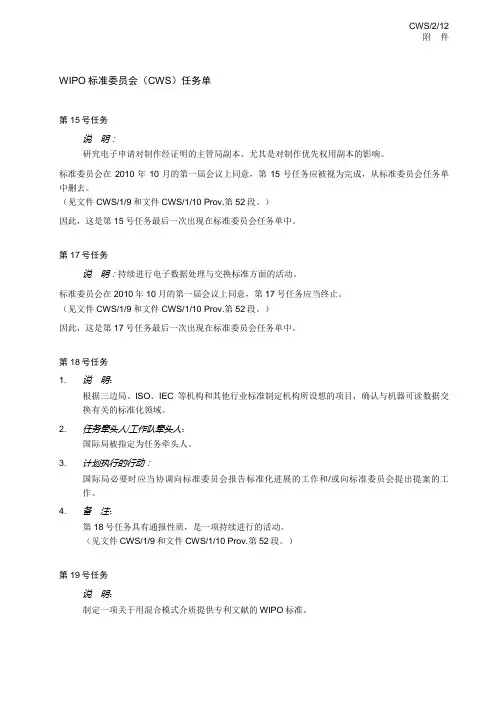
附件WIPO标准委员会(CWS)任务单第15号任务说明:研究电子申请对制作经证明的主管局副本、尤其是对制作优先权用副本的影响。
标准委员会在2010年10月的第一届会议上同意,第15号任务应被视为完成,从标准委员会任务单中删去。
(见文件CWS/1/9和文件CWS/1/10 Prov.第52段。
)因此,这是第15号任务最后一次出现在标准委员会任务单中。
第17号任务说明:持续进行电子数据处理与交换标准方面的活动。
标准委员会在2010年10月的第一届会议上同意,第17号任务应当终止。
(见文件CWS/1/9和文件CWS/1/10 Prov.第52段。
)因此,这是第17号任务最后一次出现在标准委员会任务单中。
第18号任务1. 说明:根据三边局、ISO、IEC等机构和其他行业标准制定机构所设想的项目,确认与机器可读数据交换有关的标准化领域。
2. 任务牵头人/工作队牵头人:国际局被指定为任务牵头人。
3.计划执行的行动:国际局必要时应当协调向标准委员会报告标准化进展的工作和/或向标准委员会提出提案的工作。
4. 备注:第18号任务具有通报性质,是一项持续进行的活动。
(见文件CWS/1/9和文件CWS/1/10 Prov.第52段。
)第19号任务说明:制定一项关于用混合模式介质提供专利文献的WIPO标准。
标准委员会在2010年10月的第一届会议上同意,第19号任务应当终止。
(见文件CWS/1/9和文件CWS/1/10 Prov.第52段。
)因此,这是第19号任务最后一次出现在标准委员会任务单中。
第20号任务1. 说明:按文件SCIT/SDWG/11/9第5段中所述,讨论商标领域与数字图像格式以及颜色管理和网上公告有关的各项问题,并编写后续提案。
2. 任务牵头人/工作队牵头人:任务牵头人是商标标准工作队牵头人,即韩国知识产权局(KIPO)。
3. 计划执行的行动:商标标准工作队将向标准委员会第二届会议提交审议一份文件SCIT/SDWG/11/9第5段中所述的关于数字图像格式、颜色管理和网上公告的提案。
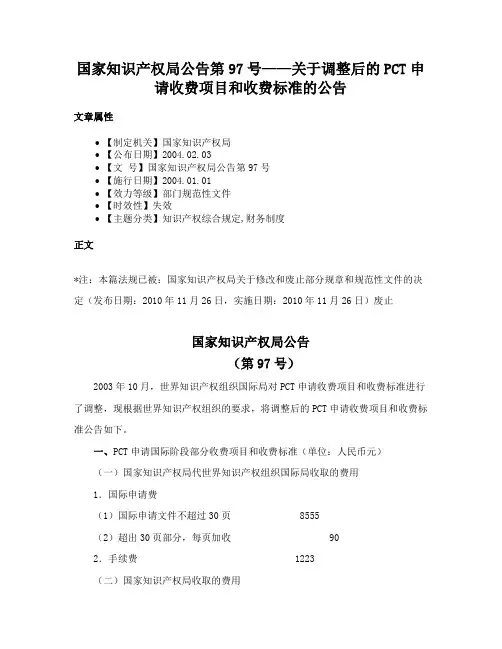
国家知识产权局公告第97号——关于调整后的PCT申请收费项目和收费标准的公告文章属性•【制定机关】国家知识产权局•【公布日期】2004.02.03•【文号】国家知识产权局公告第97号•【施行日期】2004.01.01•【效力等级】部门规范性文件•【时效性】失效•【主题分类】知识产权综合规定,财务制度正文*注:本篇法规已被:国家知识产权局关于修改和废止部分规章和规范性文件的决定(发布日期:2010年11月26日,实施日期:2010年11月26日)废止国家知识产权局公告(第97号)2003年10月,世界知识产权组织国际局对PCT申请收费项目和收费标准进行了调整,现根据世界知识产权组织的要求,将调整后的PCT申请收费项目和收费标准公告如下。
一、PCT申请国际阶段部分收费项目和收费标准(单位:人民币元)(一)国家知识产权局代世界知识产权组织国际局收取的费用1.国际申请费(1)国际申请文件不超过30页8555(2)超出30页部分,每页加收902.手续费1223(二)国家知识产权局收取的费用1.传送费5002.检索费1500附加检索费15003.优先权文件费1504.初步审查费1500初步审查附加费15005.单一性异议费2006.副本复制费(每页) 27.滞纳金按应缴纳费用的50%计收;滞纳金数额按最低不少于传送费,最高不多于国际申请费(1)项的50%收取。
二、PCT申请进入中国国家阶段部分的收费项目和收费标准(单位:人民币)(一)宽限费1000(二)改正译文错误手续费(初审阶段)300(三)改正译文错误手续费(实审阶段)1200(四)单一性恢复费900(五)改正优先权要求请求费300三、说明本公告中的国际申请费和手续费是国家知识产权局代世界知识产权组织国际局收取的,其收费标准是按2003年12月31日国家外汇管理局公布的外汇牌价计算的。
实际收费以国家知识产权局向世界知识产权组织国际局转费当日外汇牌价计算。
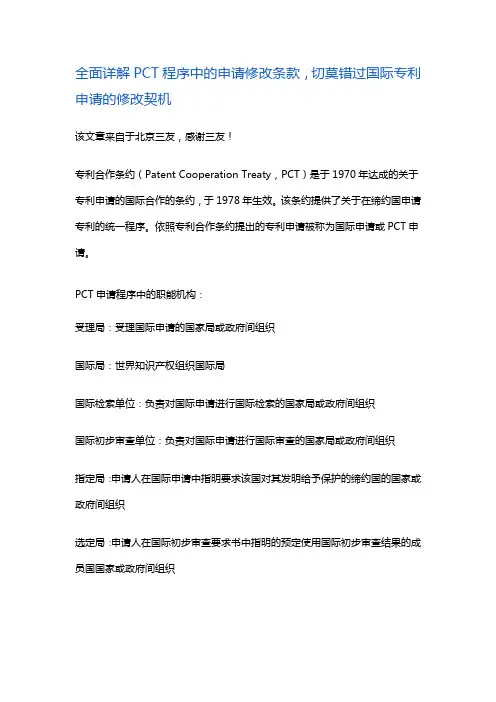
全面详解PCT程序中的申请修改条款,切莫错过国际专利申请的修改契机该文章来自于北京三友,感谢三友!专利合作条约(Patent Cooperation Treaty,PCT)是于1970年达成的关于专利申请的国际合作的条约,于1978年生效。
该条约提供了关于在缔约国申请专利的统一程序。
依照专利合作条约提出的专利申请被称为国际申请或PCT申请。
PCT申请程序中的职能机构:受理局:受理国际申请的国家局或政府间组织国际局:世界知识产权组织国际局国际检索单位:负责对国际申请进行国际检索的国家局或政府间组织国际初步审查单位:负责对国际申请进行国际审查的国家局或政府间组织指定局:申请人在国际申请中指明要求该国对其发明给予保护的缔约国的国家或政府间组织选定局:申请人在国际初步审查要求书中指明的预定使用国际初步审查结果的成员国国家或政府间组织PCT中的规定主要涉及在缔约国之间对专利申请的提出、检索和审查等方面进行合作,其目标是建立起PCT申请体系:在提交国家申请后12个月内提交一份PCT国际申请,指定要获得保护的国家,并要求巴黎公约规定的优先权。
(韩一星注:上面图中的指定局和选定局应该是写颠倒了,初审的应该是选定局,进入国家阶段的应该是指定局)它的优势在于:·简化提出申请的手续·推迟决策时间·准确投入资金·完善申请文件·减轻成员国国家局的负担(应当注意的一点是:专利申请人只能通过PCT申请专利,不能直接通过PCT 得到专利。
要想获得某个国家的专利,专利申请人还必须履行进入该国家的手续,由该国的专利局对该专利申请进行审查,符合该国专利法规定的,授予专利权)按照PCT条约及其细则的规定,一个国际申请,从其申请之日起到获得专利权,会经历一个漫长的过程,在实务操作的过程中,我们有时会遇到这样的情形:在PCT申请提交后,发现提交文件有问题需要补正或修改,这时我们应该怎么办?PCT应该怎样修改?在什么阶段进行修改?要修改哪些内容?相信这些都是困扰大家的问题,所以本文将详细为你讲解PCT申请中一个重要环节——PCT的修改,具体从国际阶段和国家阶段两个层面入手。
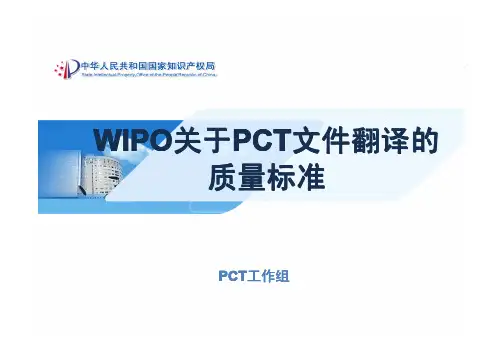
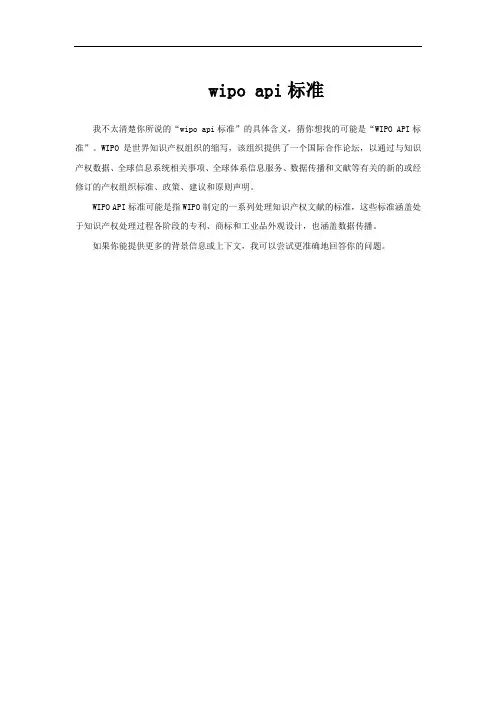
wipo api标准
我不太清楚你所说的“wipo api标准”的具体含义,猜你想找的可能是“WIPO API标准”。
WIPO是世界知识产权组织的缩写,该组织提供了一个国际合作论坛,以通过与知识产权数据、全球信息系统相关事项、全球体系信息服务、数据传播和文献等有关的新的或经修订的产权组织标准、政策、建议和原则声明。
WIPO API标准可能是指WIPO制定的一系列处理知识产权文献的标准,这些标准涵盖处于知识产权处理过程各阶段的专利、商标和工业品外观设计,也涵盖数据传播。
如果你能提供更多的背景信息或上下文,我可以尝试更准确地回答你的问题。
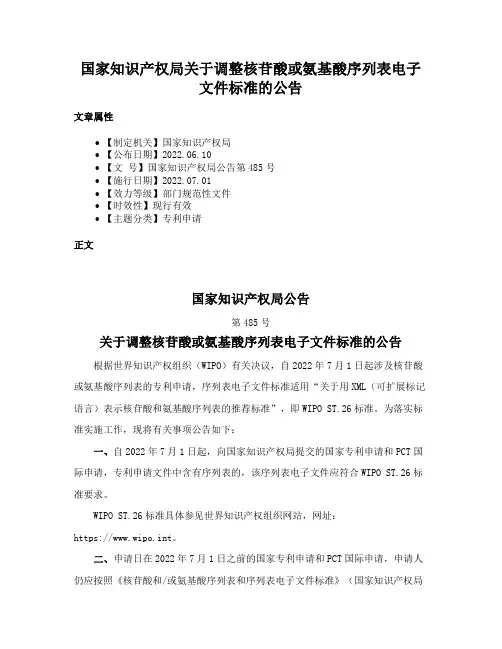
国家知识产权局关于调整核苷酸或氨基酸序列表电子
文件标准的公告
文章属性
•【制定机关】国家知识产权局
•【公布日期】2022.06.10
•【文号】国家知识产权局公告第485号
•【施行日期】2022.07.01
•【效力等级】部门规范性文件
•【时效性】现行有效
•【主题分类】专利申请
正文
国家知识产权局公告
第485号
关于调整核苷酸或氨基酸序列表电子文件标准的公告
根据世界知识产权组织(WIPO)有关决议,自2022年7月1日起涉及核苷酸或氨基酸序列表的专利申请,序列表电子文件标准适用“关于用XML(可扩展标记语言)表示核苷酸和氨基酸序列表的推荐标准”,即WIPO ST.26标准。
为落实标准实施工作,现将有关事项公告如下:
一、自2022年7月1日起,向国家知识产权局提交的国家专利申请和PCT国际申请,专利申请文件中含有序列表的,该序列表电子文件应符合WIPO ST.26标准要求。
WIPO ST.26标准具体参见世界知识产权组织网站,网址:
https://www.wipo.int。
二、申请日在2022年7月1日之前的国家专利申请和PCT国际申请,申请人仍应按照《核苷酸和/或氨基酸序列表和序列表电子文件标准》(国家知识产权局
令第15号)和《关于知识产权行业标准〈电子文件标准〉中部分特征关键词表的修订》(国家知识产权局公告第二四八号)规定的电子文件标准提交序列表。
三、专利申请人以电子形式提交国家专利申请,在提交符合WIPO ST.26标准的序列表电子文件时,为核算说明书附加费用,应同时提交一份PDF格式的序列表文件。
特此公告。
国家知识产权局
2022年6月10日。
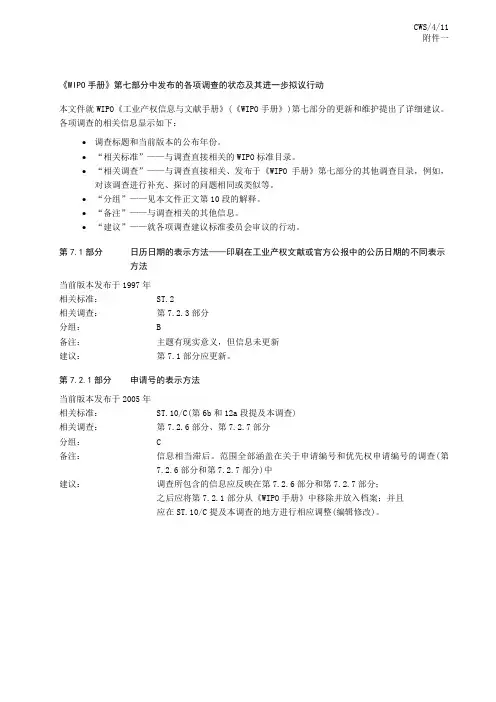
附件一《WIPO手册》第七部分中发布的各项调查的状态及其进一步拟议行动本文件就WIPO《工业产权信息与文献手册》(《WIPO手册》)第七部分的更新和维护提出了详细建议。
各项调查的相关信息显示如下:•调查标题和当前版本的公布年份。
•“相关标准”——与调查直接相关的WIPO标准目录。
•“相关调查”——与调查直接相关、发布于《WIPO手册》第七部分的其他调查目录,例如,对该调查进行补充、探讨的问题相同或类似等。
•“分组”——见本文件正文第10段的解释。
•“备注”——与调查相关的其他信息。
•“建议”——就各项调查建议标准委员会审议的行动。
第7.1部分日历日期的表示方法——印刷在工业产权文献或官方公报中的公历日期的不同表示方法当前版本发布于1997年相关标准:ST.2相关调查:第7.2.3部分分组: B备注:主题有现实意义,但信息未更新建议:第7.1部分应更新。
第7.2.1部分申请号的表示方法当前版本发布于2005年相关标准:ST.10/C(第6b和12a段提及本调查)相关调查:第7.2.6部分、第7.2.7部分分组: C备注:信息相当滞后。
范围全部涵盖在关于申请编号和优先权申请编号的调查(第7.2.6部分和第7.2.7部分)中建议:调查所包含的信息应反映在第7.2.6部分和第7.2.7部分;之后应将第7.2.1部分从《WIPO手册》中移除并放入档案;并且应在ST.10/C提及本调查的地方进行相应调整(编辑修改)。
第7.2.2部分工业产权局使用或计划使用的申请、公布文献和注册权利编号体系调查当前版本发布于2001年相关标准:ST.10/C、ST.13、ST.6相关调查:第7.2.6部分、第7.2.7部分分组: C备注:信息相当滞后。
范围部分涵盖在关于申请编号和优先权申请编号的调查(第7.2.6部分和第7.2.7部分)中,关于公布文献编号和注册权利编号的信息(表二)除外建议:调查所包含的关于申请编号和优先权申请编号的信息应反映在第7.2.6部分和第7.2.7部分;应开展关于公布号和注册号的新调查;并且之后应将第7.2.2部分从《WIPO手册》中移除并放入档案。
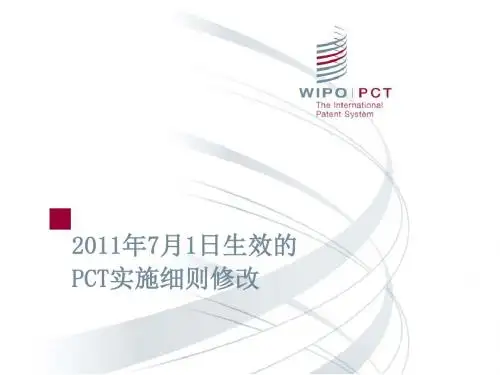
PCT19-28-34-41条修改介绍第一篇:PCT19-28-34-41条修改介绍1、总的原则:所有修改不能超出原始说明书及权利要求记载的范围;2、修改的阶段:按专利合作条约(PCT)第19、34条修改发生在国际阶段;按28/41条修改发生在国家阶段。
如果PCT申请没有进入国家阶段,就不会出现按第28/41条修改。
3、按19条修改,发生在PCT第I章规定的程序中:提出PCT国际申请后,检索单位在一定的时间(通常几个月吧)内会做出检索报告,并制作书面意见发给申请人,申请人自该文件发出日起2月内,针对检索报告及书面意见中的问题,可以向国际局提交修改文件。
注意:按19条修改只能修改权利要求,不能修改说明书等。
修改后的文本随公开文本一起公布(公开文件中有两份权利要求——原始提交的和后来修改的);4、按34条修改,发生在PCT第II章规定的程序中,这一程序为可选程序,如果申请人在收到第I章程序中的国际检索报告和书面意见后,发现专利性不高,想修改文件并进一步想知道修改后的文件的专利性,那么可以向国际局提出请求来启动第II章程序,需要另外缴纳规定的费用。
注意:按34条修改可以修改权利要求书及说明书等等。
启动第II 章程序这一阶段也就是所谓的国际初步审查,提交的修改文件(审查基础文件)以附件的形式提交,所以在《审查指南》中是以“国际初步报告附件的译文”字样出现(就是这个意思了)。
5、按28/41条修改,即进入国家阶段时的修改,表述“28/41”不必分开,只要是在进入国家阶段时修改都可以这样写,不必管是按28还是41条修改。
大致解释一下:上面提到过PCT第I章程序、PCT 第II章程序,这两章程序中分别对应28和41条。
按28/41条修改可以修改权利要求和说明书等。
注意:如果未对文件作出任何修改,就没有必要请求按34条进行修改,即使申请按34条修改,得出的结论跟之前的检索报告一模一样。
所以,要启动34条程序,请修改文件后再进行。
《PCT国际检索和初步审查单位指南》的最新修改作者:傅琦来源:《职工法律天地·下半月》2017年第10期摘要:国际检索和初步审查是PCT程序中的重要程序。
《PCT国际检索和初步审查指南》不仅为国际检索单位和初步审查单位提供操作指南,也为申请人及专利从业者准确理解和有效利用PCT制度提供帮助。
本文介绍了《PCT国际检索和初步审查指南》最新修改的主要内容。
关键词:PCT;检索;初步审查;指南;修改一、引言PCT(Patent Cooperation Treaty专利合作条约)是专利领域的一项国际合作条约。
通过PCT,申请人只需提交一份“国际”专利申请,即可请求在所有PCT缔约国中同时对其发明进行专利保护。
近年来,中国申请人逐渐加大了对PCT制度的利用,以便获得专利的全球保护。
二、《PCT国际检索和初步审查指南》PCT程序主要包括提交申请、国际检索、国际公布、补充国际检索(可选)、国际初步审查(可选)、国家阶段等,其中国际检索和初步审查帮助申请人获得可专利性的有用信息,是PCT程序中的重要程序。
PCT体系包括《专利合作条约》、《PCT实施细则》、《PCT行政规程》、《PCT受理局指南》、《PCT申请人指南》、《PCT国际检索和初步审查指南》等多项法律法规,其中《PCT国际检索和初步审查指南》不仅为国际检索单位和初步审查单位提供了应遵循的操作指南,也为申请人及专利从业者准确理解和有效利用PCT制度提供了帮助。
《PCT国际检索和初步审查指南》几乎每年均有更新,最新修改的《PCT国际检索和初步审查指南》于2017年7月1日起正式生效。
下面,笔者对最新修改的主要内容进行介绍。
三、修改内容(一)关于多项从属权利要求第九章“国际检索和国际初步审查的排除和限制”中“多项从属权利要求”小节中对9.41段的表述进行了调整(内容无实质变化),并增加9.41A和9.41B段,明确了:当独立权利要求包含对两项以上权利要求的引用并且作为多项从属权利要求的基础时,如果作为国际检索单位的专利局的国内法不允许用这一方式撰写多项从属权利要求,国际检索单位也可以根据条约第17条(2)(b)作出说明;但只有在不能进行有意义的检索以及在某范围内不能进行有意义的检索时才作出这种说明;这种情况也要在书面意见中指明;确定一项权利要求是否为多项从属权利要求,审查员不仅应当考虑该权利要求本身的形式,而且应当考虑所述权利要求引用的权利要求;任何从属权利要求,只要引用多项从属权利要求或者引用包含对两项以上权利要求的引用的独立权利要求,都应当被认为是多项从属权利要求,因而不应当作为其他任何多项从属权利要求的基础。
wipo st.26标准要求-回复WIPO ST.26标准要求,简称ST.26,是WIPO(世界知识产权组织)的一项标准,专门针对电子文件的存储和传输进行规范。
其目的是为了确保各国知识产权机构能够安全、高效地共享电子文件,提高知识产权管理的效率和准确性。
ST.26标准的要求包括以下几个方面:1. 文件格式和结构:ST.26要求电子文件采用XML(可扩展标记语言)格式存储,并按照特定的结构进行组织。
XML格式具有良好的可读性和可扩展性,能够方便地与其他系统进行集成和交互。
2. 数据字段和元数据:ST.26规定了一系列标准数据字段和元数据,用于描述和标识电子文件中包含的信息。
这些字段和元数据包括文件类型、文件版本、文件创建时间、版权信息等,以确保文件的准确性和完整性。
3. 文件命名和目录结构:ST.26要求文件采用统一的命名规则和目录结构进行管理。
文件命名应具有一定的规范性和可读性,并能够反映文件的内容和属性。
目录结构应合理划分,便于文件的检索和管理。
4. 文件传输和安全性:ST.26规定了电子文件的传输方式和安全性要求。
文件传输应采用加密的通信协议,确保数据在传输过程中的安全性和完整性。
同时,还要求对文件进行数字签名和时间戳的验证,以确保文件的真实性和可信度。
为满足ST.26标准的要求,知识产权机构需要进行以下几个步骤:第一步:制定合适的文件存储和传输策略。
机构需要评估自身的需求,选择合适的存储和传输方案。
这可能涉及到硬件设备的采购和网络基础设施的建设。
第二步:制定文件格式和结构规范。
机构需要确定采用的文件格式和结构,并建立相应的标准和指导文件。
这包括确定XML的使用规范和相关的数据字段和元数据。
第三步:制定文件命名和目录结构规范。
机构需要制定文件命名和目录结构的规范,并培训相关人员。
这样可以确保文件的统一管理和检索。
第四步:选择合适的文件传输方式。
机构需要评估不同的文件传输方式,并选择安全可靠的传输方案。
欧专局放宽PCT申请修改要求
任晓玲
【期刊名称】《中国发明与专利》
【年(卷),期】2011(000)012
【摘要】根据欧洲专利局(EPO)的最新规定,选择欧专局作为国际初步审查单位的PCT申请人,可在国际初步审查阶段向欧专局提交两次修改或答复意见。
此规定自2011年10月4日生效,适用于2011年12月1日当天或之后国际初步审查报告撰写期限届满的PCT申请。
【总页数】1页(P109-109)
【作者】任晓玲
【作者单位】国家知识产权局专利局文献部
【正文语种】中文
【中图分类】TQ323.41
【相关文献】
1.欧专局裁定不再承认瑞士型权利要求的合理性 [J], 任晓玲
2.聚焦清洁能源专利申请——欧专局即将推出该领域新分类体系 [J], 任晓玲
3.欧专局2009年度报告:专利申请受理量降幅明显 [J], 任晓玲
4.关于欧专局分案申请修订条款之解析 [J], 莎日娜
5.欧专局2011专利申请量创新高 [J],
因版权原因,仅展示原文概要,查看原文内容请购买。
PCT专利文献英文翻译质量要素及评价标准
裘杨蕾
【期刊名称】《海外英语(上)》
【年(卷),期】2018(000)007
【摘要】PCT专利文献的英文翻译的优劣直接关系到PCT专利申请的质量以及授权后保护范围的确定.该文对2017年河南省PCT专利申请英文翻译过程中存在的共性问题进行总结,通过实例研究和理论研究,提出改进英文翻译质量的解决方案;通过提出PCT专利文献英文翻译的"质量要素"这一概念,提炼出三大影响PCT专利文献英文翻译质量的要素,即"法律要素"、"技术要素"和"语言要素",进一步地总结出PCT专利文献英文翻译的翻译规范,力求为专利文献的英文翻译实践时提供全面、系统、专业的参照.最后,提出了PCT专利文献英文翻译质量的评价标准,为PCT专利文献英文翻译质量评价提供客观的参考指标.
【总页数】3页(P123-125)
【作者】裘杨蕾
【作者单位】郑州成功财经学院,河南巩义451200
【正文语种】中文
【中图分类】H315.9
【相关文献】
1.专利文献在专利贸易中的作用——企业利用专利文献之三 [J], 许俊浩
2.医疗方法的可专利性
——"利用基因组测序诊断胎儿染色体非整倍性"PCT发明专利申请驳回复审案1 [J], 管荣齐
3.苏联组织专利文献馆藏概况——苏联专利事业和专利文献介绍之三 [J], 王书坤
4.PCT专利文献英文翻译质量要素及评价标准 [J], 裘杨蕾
5.从PCT专利申请看瑞典产业布局和创新之路——2003~2007年瑞典PCT专利申请分析 [J], 宋超;武悦
因版权原因,仅展示原文概要,查看原文内容请购买。